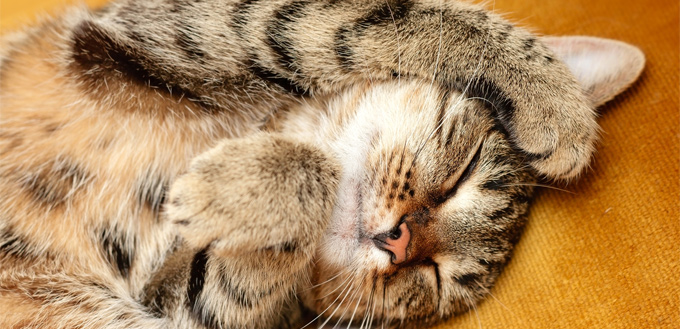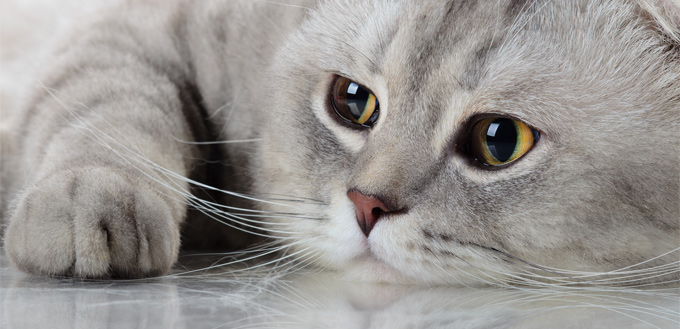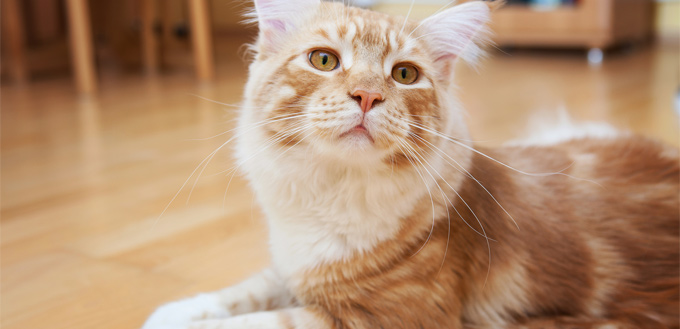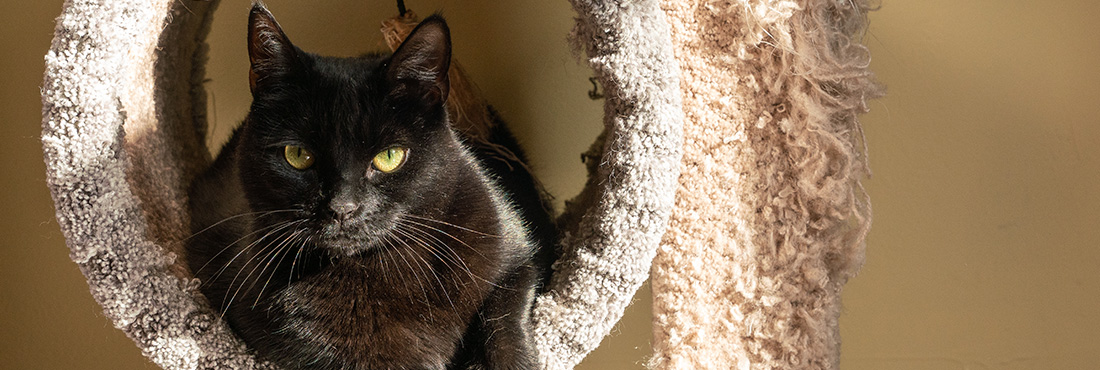Although they are fully covered in fur from head to paw, it that doesn’t mean that they wouldn’t suffer from any kinds of skin conditions. Yes, we are talking about your little kitty cat. Whether it’s stress, weather, fleas or anything else that’s causing skin conditions in them, it’s a universal problem in cats.
Your cat might start growing skin condition, just like us, humans. We don’t often pay attention to that since they are all covered with a thick layer of fur. However, when skin problems arise, they will just be as cramped-up as anybody else. If you really want to help your cat when such problems arise, what you need to do is pay attention to the signs and symptoms concerning this.

Signs of Skin Problems in Cats
Some of the major signs of skin conditions in cats are too much rubbing against the sofa or carpet, too much licking, pawing their mouth and ears all the time and/or trying to chew their skin. Other signs include:
- Bald patches
- Inflamed or redness in the skin
- Sores and dryness
- Dullness or matted fur
- Lumps
- Rashes
These are some of the very basic signs of skin conditions, but it could vary from what’s causing this to happen. It’s best to contact your vet if you notice any of these conditions in your cat. Bear it in mind that cats are notorious creatures and will try their best to hide these conditions and illness. For instance, your cat will wait until you leave the house or look for hideouts to satisfy themselves from that itch.
Does your cat show any of these symptoms? No? Thank goodness.
Now familiarize yourself with some of these other skin problems that your cat might encounter and how you can possibly deal with them:
Ear Mites
These are tiny parasites that can be extremely irritating and cause your cat to shake their head or paw their ears a little too often. As a result, this excessive pawing might lead to pulling their hairs around the ear area and thus result into bleeding. You may also see tiny, dark bumps inside the ear canal with a debris around their ear. Ear mites have the tendency to spread from one pet to another. To avoid this from happening, do make sure that you check other pets in your house as well.
How to Handle Ear Mites
Once you take your cat to the vet, they will clean the ears and prescribe special ear drops. These ear drops comprise of a mite-killing chemical that will get rid of the mites. They might as well ask you to clean their ears with a cotton swab before applying the drops. Follow your vet’s instructions and apply the drops for a week or so and your pet cat will be all fine.
Abscesses
Abscesses are by far the most common skin problem among cats. It’s the painful collection of pus in and around the area of a punctured wound. When abscesses occur, it forms a hard swelling at first and eventually becomes soft that can rupture and release the purulent substance. Abscesses are mostly found on a cat’s belly as a result of a cat-fight or sometimes even near their tail when they get bitten by other creatures while trying to run away.
How to Handle Abscess
Use a small, clean piece of cloth and soak it in warm water. Hug it around the wound for a minute or two. This will loosen the fur and will make the cat feel good if they can bear with it for a while. On top of that, hydrogen peroxide is a safe (non-prescribed) sterilizer that you could put on their wound too.
Cat Acne
It is very likely for your cat to get acne. It’s called comedones (most commonly known as blackheads) that form under the chin or on the edges of a cat’s lips. What causes this to occur is the germ on their food and water bowl (plastic or rubber).
How to Handle Cat Acne
In some severe cases, antiseborrheic shampoos, the ones that contain benzoyl peroxide (at least 3% or less) or benzoyl peroxide gels, perform in breaking the excess oil that your cat’s body produces. Try it!

Ringworm
Even though the name says “ringworm”, it’s not caused by a worm. In fact, it’s caused by fungi. The word ring refers to the round shape that appears on the skin when the infection occurs. Ringworm is not a pretty sight on cats. It is also spreadable and spreads through spores on the fur that circulates in the air. If your cat gets diagnosed with ringworm, be sure to separate your other pets from your ringworm infected cat. Newborn kittens or very old cats are susceptible to ringworm. You’ll notice bald patches, crusty skin and inflammation in circles.
How to Handle Ringworm
If you detect that your cat has ringworm, consult your vet and get prescribed with an anti-fungal treatment. In addition to that, wash off any blanket, bedding, bed covers and other areas where your cat has sat or spent time. This is to ensure that the fungi don’t stick or spread around. If you own a Persian cat, a British Long Hair or any breed with long and thick fur, you could give him/her a trim to help them get rid of the spores.
As per the ASPCA, you can make use of chlorine bleach (¼ cup in a gallon of water), benzalkonium chloride and/or strong cleaning products to kill the bacteria that caused ringworm in your cat. Remember, not to mix these products as the chemicals, when mixed, form harmful gases.
Lumps
Lumps are cancerous, but not all. If you ever notice one in your cat’s skin, don’t assume that it might also be cancer. It could be a non-malignant tumour or a cyst. To get rid of any doubt, get your cat checked by a vet to inspect the lump and possibly perform a biopsy too, just to check if it’s malignant.
How to Handle Lumps
Usually, the lump needs to be removed through a surgical process. Sometimes that’s the only way to treat lumps. And by any chance, if the lump is cancerous, the treatment could include chemotherapy or radiation too.
Sunburn in Cats
Your cat might love the heat and warmth that the sunlight provides them with, but too much exposure to the sun could lead to skin problems. If you are the parent of a light-coloured furry cat or a hairless breed such as Sphynx, make sure to keep them away from the sun. They are prone to sunburn, especially the sunlight during the afternoon between 10 am and 2 pm.
How to Handle Sunburn
The easiest and effective treatment for sunburn is to spray cold water from a sprinkler every half an hour. And if your cat can’t stand being sprayed, soak a small piece of cloth in ice water and apply it on their skin as the cold presses the affected area.
Allergic Reactions
As you know that your pet cat is a very sensitive creature and that they are prone to developing allergies during their lifetime. There’s no end to what your cat might be allergic to. Starting from perfumes, cigarette smoke, shampoos, pollen, detergents, different types of foods and fleabites, you’ll never be able to figure out what’s the real cause of the allergy. Again, your vet would have the best suggestion about such skin issues and will also help you identify the type of allergy that your cat might be facing.
How to Handle Allergic Reactions
Many a time antihistamines are useful to cure allergic reactions in cats. However, please don’t give any random medications to your pet cat as it might make matters worse by having an even more allergic reaction in them. Human medication is a big NO! Therefore, seek vet consultation.
You May Also Like: Hypoallergenic Cat Food

Fleas
Just like the way your cat chases bugs, they are very likely to get picked up by pesky little bugs. Only indoor cats are less likely to get them and even if they do, it would be from other pets in the house. Fleas themselves can be very irritating and on top of that, their bites are what causes an allergic reaction and excessive itching in cats.
If itching persists for more than a week, carefully look over to your cat’s skin and fur. These little bugs look for warm spots and are more visible near the base and rear ends of a cat’s ears. But they could be in any parts of their body too. Here’s how to look for fleas:
- Look through the fur and search for small brown moving specks.
- Be patient – fleas run on the other direction when they are exposed to air and light.
- Notice any flea droppings that look like black pepper or bits of dirt.
How to Handle Fleas
One easy way of looking for fleas are brushing your cat over a white paper. Dampen any small specks that you see with a little bit of water. If they turn red, it might be a sign of flea faeces. Additionally, a light crimson colour is an effect of the blood ingested consumed by the little bug. And don’t use any fleas’ medications yet as cats are extremely sensitive to flea products. Talk it out to your vet before using any flea related products or other over-the-counter remedies.
You May Also Like: Flea Comb for Cats, Flea Shampoo for Cats, Flea Collars for Cats and Flea Treatments For Cats.
Dryness in Cat’s Skin
Cats are prone to getting dry skin just like humans, especially in climates that are too humid or too cold and the air is evaporating out. Another cause of dry skin could be nutritional deficiencies like dehydration and/or a lack of fats in the cat’s diet. Take note of the fact that your cat is drinking enough fluids and the choices of food are healthy.
How to Handle Dry Skin
Are you giving them enough omega-3 supplements? Along with the other benefits of fish oil, it also helps in moistening their skin and some tests have shown remarkable results such as preventing cancer. Do brush their fur regularly in order for their natural skin oils to spread evenly.
Skin Infections
With all the aforementioned diseases, those diseases can lead to causing skin infections in cats. These infections include yeast infections and cat military dermatitis that can be a result of allergens like fleas. Check whether your cat has any other health issues like diabetes. Diabetes affected cats are an excellent candidate for skin infections. One way of knowing that your cat is suffering from skin infection is if they overgroom themselves or try to relieve from the irritation and itching. Overgrooming will cause bald spots, matted fur and thus rashes.
How to Handle Skin Infections
Prescribed medications are the only way to treat these underlying diseases. Note that skin infections are severe and injurious. Only the antifungal or antibacterial medication can cure this skin infection. The vet might also prescribe an antiseborrheic shampoo to treat that you need to make use of until the infection comes under control.
Causes of Skin Problems in Cats
Generally, the healthier your cat’s coat is, the healthier they are on the inside too. However, if they are overgrooming themselves and scratching themselves a bit too much, then this might be a red flag. While the real cause of this might take a little while to investigate, here are some of the basic causes of cat skin problems:
- Food Allergen
Have you recently made any changes to your cat’s diet without consulting your vet? It could be a reaction to the new diet. Or your cat must have eaten something that they shouldn’t have. Normally, food allergens cause gastrointestinal issues and thus vomiting and diarrhoea. In order to prevent this from happening, make a list of the food items that your cat is allergic to and strictly avoid giving them that food. Plus, do not leave anything carelessly on the table or anywhere else that your cat might get access to, which later would lead to health conditions.
- Environmental Allergies
In what type of environment you keep your cat has a huge impact on their skin. Environmental allergies (a.k.a. cat atopy) stem from a different type of allergens such as grass, mites, and pollens and causes your cat to non-stop scratch themselves. You’ll notice red, irritated patches and small bumps under their fur or possibly stained fur that they keep licking all the time. That’s when you know that your cat is inflicted with some kind of allergy.
Luckily, certain diets and special medications can help ease these infections. All you need to do is balance the number of nutrients to level out cat atopy. This involves an ideal combination of nutrients that help protect your cat’s skin with a good amount of omega-3 fatty acids from fish oil that helps in minimizing skin inflammation.
- Parasites
Parasites, namely fleas and mites, are the most common skin nuisance in cats. Fleas are terrible and will cause severe scratching and itching in your cat, especially around their hindquarters. As mentioned above, you already know how painful ear mites can be. Therefore, treat your cat appropriately by taking them to the local pet clinic as soon as possible.
Fun fact: Cats spend more than 30% of their awake time by grooming and cleaning their coats!
Prevent Skin Problems in Cats
We’re sure you already care enough about your fluffy friend and take complete care of them. However, we’ve listed some additional ways you can prevent these skin conditions from occurring at the first place:
- Feed a balanced, high-quality diet to prevent skin conditions: The best you could choose a high-quality diet with all the necessary nutrient that will help in maintaining an excellent health.
- Maintain their weight: This is probably a little too difficult but keeping your cat lean is beneficial in many ways, which includes hindrance of skin problems.
- Keep those parasites away: Regular brushing and bathing can help in removing those allergens from the skin. In addition, brushing will spread the natural oils evenly and promote shiny, healthy fur. And remember to use a feline shampoo that has natural ingredients in it because obviously, we cannot regard chemicalized products as being pet-friendly.
Bottom Line
A happy cat is a healthy cat! Since skin problems in cats are quite common, there’s no need to panic if you notice some of these symptoms in your cat. The first course of action is to calm down. Look for what’s causing this to happen and take steps accordingly. Cat allergies might not be completely curable but they can be prevented and managed in a manner that will reduce your cat’s suffering. Whatever the case is, do take early steps to prevent the problem from growing.
Have you tried any skin treatment that had an adverse effect? Did you find any natural remedy for treating skin infections in cats? Do let us know in the comments section below!
Sources:
- Feline Skin Diseases, Cornell University College of Veterinary Medicine
- Alison Diesel, Common Feline Skin Conditions, Veterinary Medicine & Biomedical Sciences
Note: The advice provided in this post is intended for informational purposes and does not constitute medical advice regarding pets. For an accurate diagnosis of your pet's condition, please make an appointment with your vet.






